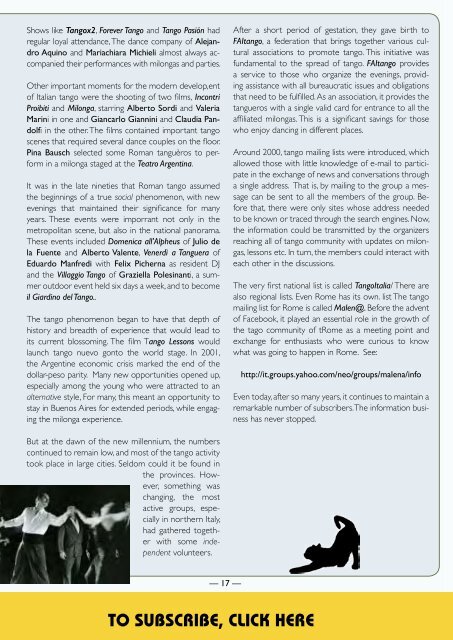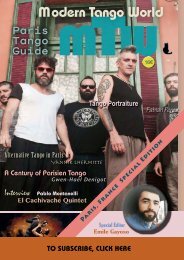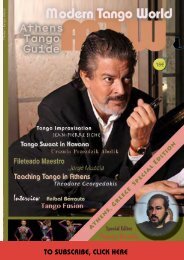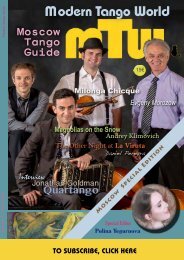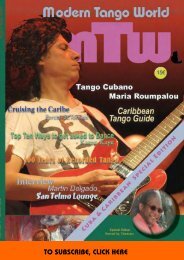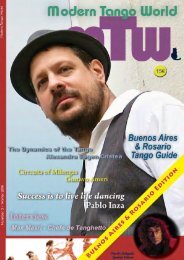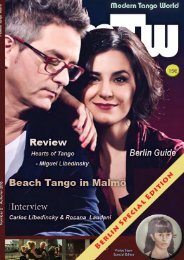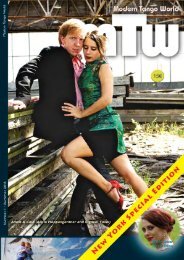Modern Tango World #9 (Rome, Italy)
Rome Special Features Symbolic Roman Tango Places Mario Abbati 03 Milongas in Rome Enrico Colagrossi 08 Roman Tango, 1980 to Present Emanuela (Mela) Molinari 13 Roman Road to NeoTango Elio Astor 16 Guide to Tango in Rome 20 Endless Tango William Hudson Temples 26 Interview with Mariano Mattone (Tangothic) Raymond Lauzzana 30 Visual dancing Andreas Lange 33 From León to Patagonia and Back Eduardo Delgado Hernández 36 New Tango Music Arndt Büssing 40 Tango Moves: Ochos (Figure Eights) Raymond Lauzzana 44
Rome Special Features
Symbolic Roman Tango Places Mario Abbati 03
Milongas in Rome Enrico Colagrossi 08
Roman Tango, 1980 to Present Emanuela (Mela) Molinari 13
Roman Road to NeoTango Elio Astor 16
Guide to Tango in Rome 20
Endless Tango William Hudson Temples 26
Interview with Mariano Mattone (Tangothic) Raymond Lauzzana 30
Visual dancing Andreas Lange 33
From León to Patagonia and Back Eduardo Delgado Hernández 36
New Tango Music Arndt Büssing 40
Tango Moves: Ochos (Figure Eights) Raymond Lauzzana 44
Create successful ePaper yourself
Turn your PDF publications into a flip-book with our unique Google optimized e-Paper software.
Shows like <strong>Tango</strong>x2, Forever <strong>Tango</strong> and <strong>Tango</strong> Pasión had<br />
regular loyal attendance, The dance company of Alejandro<br />
Aquino and Mariachiara Michieli almost always accompanied<br />
their performances with milongas and parties.<br />
Other important moments for the modern develop,ent<br />
of Italian tango were the shooting of two films, Incontri<br />
Proibiti and Milonga, starring Alberto Sordi and Valeria<br />
Marini in one and Giancarlo Giannini and Claudia Pandolfi<br />
in the other. The films contained important tango<br />
scenes that required several dance couples on the floor.<br />
Pina Bausch selected some Roman tanguèros to perform<br />
in a milonga staged at the Teatro Argentina.<br />
It was in the late nineties that Roman tango assumed<br />
the beginnings of a true social phenomenon, with new<br />
evenings that maintained their significance for many<br />
years. These events were imporrant not only in the<br />
metropolitan scene, but also in the national panorama.<br />
These events included Domenica all’Alpheus of Julio de<br />
la Fuente and Alberto Valente, Venerdì a Tanguera of<br />
Eduardo Manfredi with Felix Picherna as resident DJ<br />
and the Villaggio <strong>Tango</strong> of Graziella Polesinanti, a summer<br />
outdoor event held six days a week, and to become<br />
il Giardino del <strong>Tango</strong>..<br />
The tango phenomenon began to have that depth of<br />
history and breadth of experience that would lead to<br />
its current blossoming. The film <strong>Tango</strong> Lessons would<br />
launch tango nuevo gonto the world stage. In 2001,<br />
the Argentine economic crisis marked the end of the<br />
dollar-peso parity. Many new opportunities opened up,<br />
especially among the young who were attracted to an<br />
alternative style, For many, this meant an opportunity to<br />
stay in Buenos Aires for extended periods, while engaging<br />
the milonga experience.<br />
After a short period of gestation, they gave birth to<br />
FAItango, a federation that brings together various cultural<br />
associations to promote tango. This initiative was<br />
fundamental to the spread of tango. FAItango provides<br />
a service to those who organize the evenings, providing<br />
assistance with all bureaucratic issues and obligations<br />
that need to be fulfilled. As an association, it provides the<br />
tangueros with a single valid card for entrance to all the<br />
affiliated milongas. This is a significant savings for those<br />
who enjoy dancing in different places.<br />
Around 2000, tango mailing lists were introduced, which<br />
allowed those with little knowledge of e-mail to participate<br />
in the exchange of news and conversations through<br />
a single address. That is, by mailing to the group a message<br />
can be sent to all the members of the group. Before<br />
that, there were only sites whose address needed<br />
to be known or traced through the search engines. Now,<br />
the information could be transmitted by the organizers<br />
reaching all of tango community with updates on milongas,<br />
lessons etc. In turn, the members could interact with<br />
each other in the discussions.<br />
The very first national list is called <strong>Tango</strong>Italia/ There are<br />
also regional lists. Even <strong>Rome</strong> has its own. list The tango<br />
mailing list for <strong>Rome</strong> is called Malen@. Before the advent<br />
of Facebook, it played an essential role in the growth of<br />
the tago community of t<strong>Rome</strong> as a meeting point and<br />
exchange for enthusiasts who were curious to know<br />
what was going to happen in <strong>Rome</strong>. See:<br />
http://it.groups.yahoo.com/neo/groups/malena/info<br />
Even today, after so many years, it continues to maintain a<br />
remarkable number of subscribers. The information business<br />
has never stopped.<br />
But at the dawn of the new millennium, the numbers<br />
continued to remain low, and most of the tango activity<br />
took place in large cities. Seldom could it be found in<br />
the provinces. However,<br />
something was<br />
changing, the most<br />
active groups, especially<br />
in northern <strong>Italy</strong>,<br />
had gathered together<br />
with some independent<br />
volunteers.<br />
— 17 —<br />
TO SUBSCRIBE, CLICK HERE


